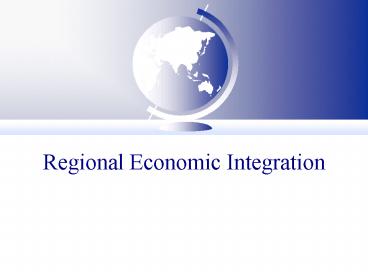Regional Economic Integration - PowerPoint PPT Presentation
1 / 12
Title:
Regional Economic Integration
Description:
Common market: same elements as customs union plus free mobility of production ... Deficit with China. Frozen value of Chinese currency ... – PowerPoint PPT presentation
Number of Views:1039
Avg rating:3.0/5.0
Title: Regional Economic Integration
1
Regional Economic Integration
2
Regional economic integrationWhy ?
- Despite the World Trade Organization, many tariff
and non-tariff barriers exist - People can often understand each other better
when they live close to each other
3
Regional Economic Integration
- Distance goods need to travel between countries
is short - Consumers tastes are likely to be similar
- Distribution channels can be easily established
- Neighboring countries may have common history and
interests - Economic integration prevents wars
7-3
4
Basic Types of Regional Economic Integration
- Free Trade Area (FTA) seeks to abolish tariffs
between member nations - Customs union eliminate internal tariffs common
external tariff on goods from outside - Common market same elements as customs union
plus free mobility of production factors such as
labor and capital - Economic integration common economic policies
- Common currency
- Political integration
7-4
5
MAJOR REGIONAL TRADING GROUPS
Free Trade Areas European Free Trade
Association Central European Free Trade
Agreement North American Free Trade
Agreement Association of South East Asian
Nations
Customs Union MERCOSUR
Common Market Caribbean Community and Common
Market Central American Common Market Andean
Group
Economic Integration European Union
6
Effects of Integration
- Static effects
- Shifting of resources from inefficient to
efficient companies as trade barriers fall - Dynamic effects
- Overall growth in market
- Expanded production
- Greater economies of scale
7-5
7
WHAT ARE THE IMPLICATIONS OF THE EU ON CORPORATE
STRATEGY?
- EU is a tremendous market
- Large, relatively prosperous population
- Likely expansion to Eastern and Central Europe
- More fragmented than U.S. market
- expansion likely to increase fragmentation
- Mergers, takeovers, and spin-offs will continue
8
IMPLICATIONS OF NAFTA ON CORPORATE STRATEGY
- NAFTA perceived as one big regional market
- Companies can rationalize production, financing
- low-end manufacturing moving south
- sophisticated manufacturing increasing in U.S.
- Canadian and Mexican companies have not been put
out of business - Mexico perceived as a market for U.S. goods, not
just a location for low-cost production
9
IMPLICATIONS OF MERCOSUR?
- MERCOSURmajor trading group in South America
- significant because of its size
- signed free trade agreements with other South
American countries - trying to become a customs union
10
IMPLICATIONS OF ASIAN TRADING GROUPS?
- Association of South East Asian Nations (ASEAN)
- promotes cooperation in industry and trade
- members rely more on U.S. market for exports than
on each other - created ASEAN Free Trade Area (AFTA)
- goal is to cut tariffs on intrazonal trade
- Asia Pacific Economic Cooperation (APEC)
- objectives are to
- resist protectionist pressures
- counter inward-looking regionalism
- deal with economic conflicts in the region
- size and diversity of members are problems
11
PROBLEMS OF INTEGRATION
- problems if new members
- have weak economies
- have serious political problems
12
Why a big US trade deficit now?
- Deficit with Europe
- European recession
- High dollar in early 2000s
- Deficit with Japan
- Slow growth of consumption in Japan
- Deficit with China
- Frozen value of Chinese currency
- Poorly developed domestic economy causes slow
growth of imports































